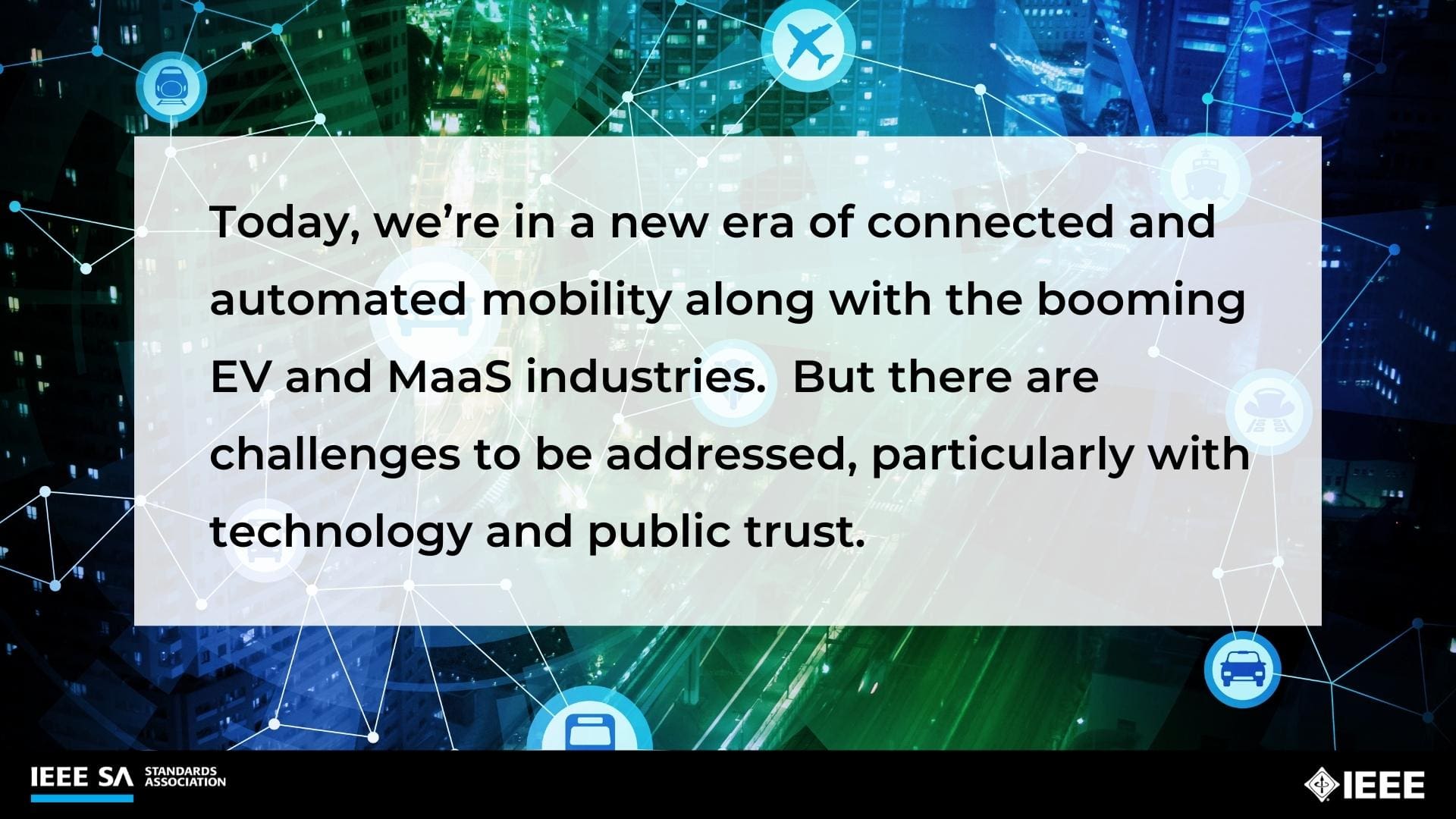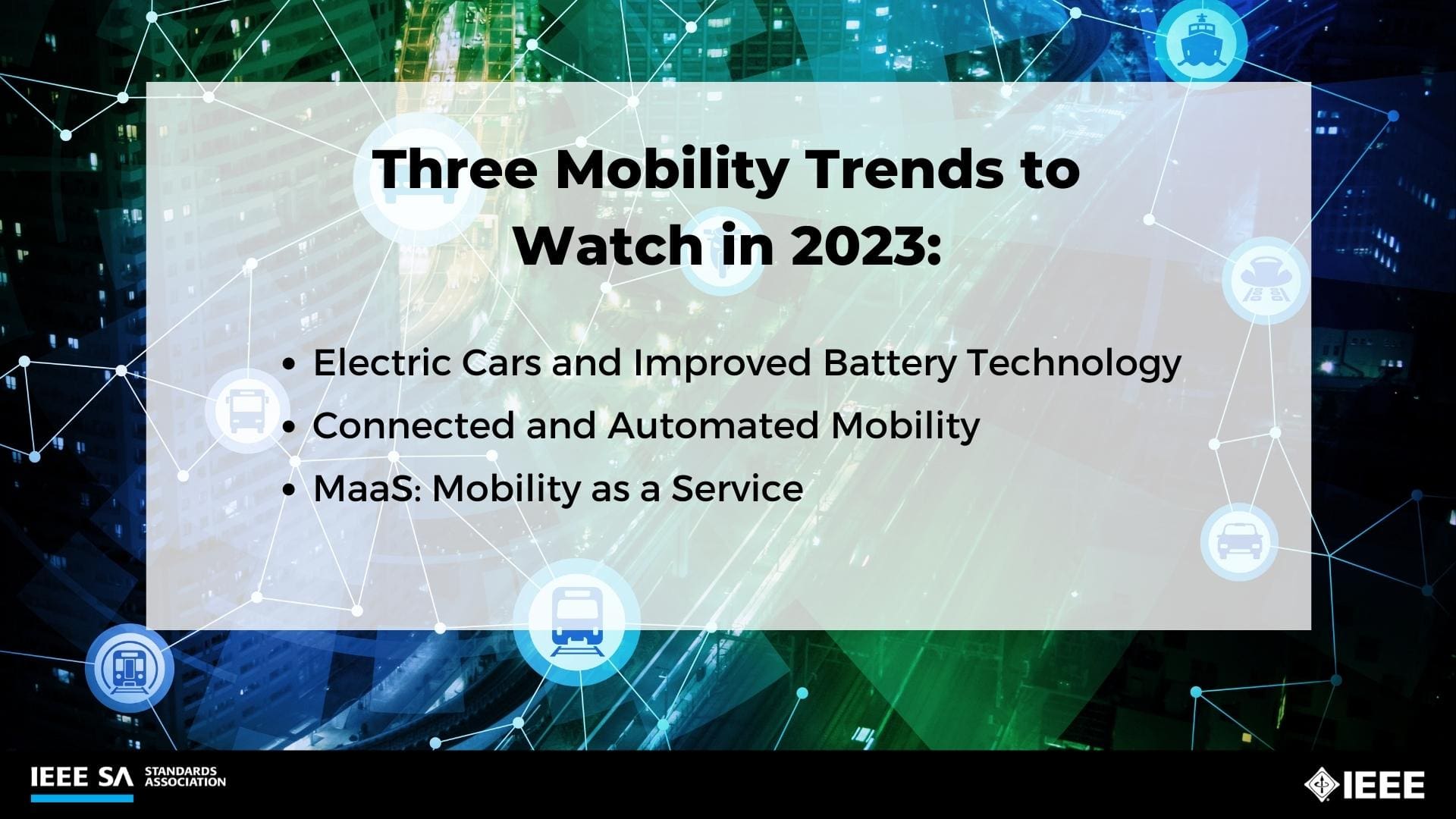Highlights:
- Sustainability, desired by governments and people, is driving the zero-emissions transportation market.
- Connected and Automated Mobility (CAM) refers to autonomous and connected vehicles, enabled by sensors, artificial intelligence, and maps. Safety is a critical factor.
- There is a shift from individually owned vehicles toward interconnected shared mobility solutions, used as an if-and-when-needed service, or Mobility as a Service (MaaS).
The first moving assembly line for the mass production of automobiles was introduced by Henry Ford in 1913, an innovation that slashed assembly time from 12 to 2.5 hours to build a vehicle. Ford later was involved with the creation of a government-funded and operated national highway network that is now the Interstate Highway System. Then and now, modes of transportation and infrastructure are enjoined to evolve, and they should in order to fully realize the potential of mobility options.
Today, we’re in a new mobility era as dynamic and exciting as what people experienced 109 years ago. Electric vehicles (EVs) are taking the industry by storm as new models are introduced to the market.
Despite rising prices of all vehicles, consumers are buying EVs at a record pace. Industry experts reported earlier this year that 458,786 new battery-electric cars (BEVs) were registered in the U.S., which is about 56% more than the previous year. Globally, EV sales rose 80% in 2021 as some of the world’s largest automakers signaled commitments to zero-emission vehicles. But there are concerns and issues to be solved, particularly with improving battery technology and charging infrastructure.
And then there’s the future for what we call Connected and Automated Mobility, which is being innovated today. Imagine commuting in heavy rain and your car’s system tells you to slow down because there’s an accident ahead that you cannot see. Or perhaps you’re in an autonomous vehicle, and it informs you it is slowing down and changing its route.
This is the result of an ecosystem of enablers such as sensors, high-definition maps, and artificial intelligence which collectively signal your car, other traffic, as well as law enforcement, of the danger. This scenario illustrates just one of the many exciting benefits of Connected and Automated Mobility. Connected cars will hit 2.5 billion connections in 2030, driving cellular IoT and 5G adoption. While we are a long way from achieving Connected and Automated Mobility, innovations are underway.
But not everyone wants to own or drive a car. Mobility as a Service (MaaS) is a type of service that, through a joint digital channel, enables users to plan, book, and pay for multiple types of mobility services. If you want a ride on a bus and then a scooter, pull out your app and book all of it. Globally, the higher costs for vehicles began with supply chain issues during the COVID-19 pandemic and continue in an inflationary economy. While MaaS can benefit all, the younger tech-savvy generation wants easy and accessible mobility. And many will use MaaS to help make the world more sustainable.
As we look toward 2023, we reflect on several advancements in the mobility sector while also noting three major trends for the coming year.

1) Energy: Electric Cars and Improved Battery Technology
As global demand for EVs has skyrocketed, so too have concerns about battery manufacturing capacity and material issues. From the consumer perspective, they want batteries that cost less, last longer, and can be charged more quickly. Consumers also want convenience, which includes more public and shared charging stations and fair, transparent pricing. They want to be able to make long trips without hassles, including difficulty finding a charging station, paying too much, and having to wait a long time for the battery to charge up.
In response, there is a strong focus by the industry on improving battery technology to meet the world’s growing demand for EVs. Lithium-ion and lithium-iron phosphate (or LFP) dominate the current EV battery landscape, each with pros and cons tied to the range, raw material prices, and lifespan. Battery companies and vehicle manufacturers are investing heavily to build batteries that are less expensive, take up less space, and weigh less. Other complicating factors inspiring innovation include materials availability, supply chain complications, and costs.
Sustainability, desired by governments and people, is driving the zero-emissions transportation market. While the EV market dominates, innovators continue to look at alternative energy solutions including hydrogen. Cars manufactured with solar-panel body parts are also being explored. But for now, the EV market is hot and so is the focus on making a better battery.
2) Connected and Automated Mobility
Connected and Automated Mobility (CAM) refers to autonomous and connected vehicles. The enablers include sensors, artificial intelligence, and maps. Autonomous vehicles, packed with cameras, sensors, and communication systems, generate massive amounts of data which, when applied with AI, enables the vehicle to perform and make decisions as though it were the driver.
Automated connectivity will highly depend on current, high-definition maps, created and updated by automated vehicles that continually collect and aggregate sensor data from static objects such as buildings and tunnels as well as newly opened or reconfigured roads. And this is the tip of the iceberg. At the most fundamental level, automated driving will rely on LiDAR, cameras, radar, and inertial sensors to provide situational awareness.
Critical to the functionality of the autonomous vehicle is safety. The autonomous vehicle must do everything a human driver can do, as safely as possible. The vehicle must perceive and understand its surroundings, process these information inputs, think about how it should and will drive the route, then safely perform the driving.
At the core of automated vehicle intelligence is the vehicle’s computer and software, which processes adaptive algorithms, continuously analyzing and interpreting incoming data from surroundings sensors and integrated mapping in real-time. Like a human driver, the autonomous vehicle knows if a nearby object is a pedestrian or a stop sign. It knows if the object is moving as well as its direction and speed, such as a cyclist on a bike path alongside it. The automated vehicle also thinks and makes judgments about what these objects might do, such as a person at a street corner that will soon enter a crosswalk. Additionally, the autonomous vehicle must be strongly protected from cyberattacks and include the redundant design of safety-critical systems.
In the United States, manufacturers of autonomous vehicles (AVs) have been road testing for a while now, but not in critical mass. Safety rules need to be defined for the industry – rules that protect everyone, including manufacturers. The IEEE 2846-2022 Standard for Assumptions for Models in Safety-Related Automated Vehicle Behavior can help provide guidance for evaluating the performance of an automated driving system which, in turn, will accelerate road testing on a larger scale. IEEE 2846 defines the minimum set of reasonable assumptions used in foreseeable scenarios to be considered for road vehicles in the development of safety-related models that are part of an automated driving system.
But there are tremendous challenges that lie ahead before we can see mass deployments of automated vehicles and enabling intelligent infrastructure. The massive, continuous exchange of data needed to execute cycles of sensing, planning, and acting requires distributed computing to include 5G mobile communications, edge computing, and the cloud. And it must be secure because, if all things are truly connected, a hacker could orchestrate dangerous incidents.
To address the trust and ethical concerns of Autonomous Intelligent Systems (AIS), the IEEE CertifAIEd™ is a certification program that helps businesses and organizations demonstrate their efforts to deliver a more trustworthy AIS experience to users.
3) MaaS: Mobility as a Service
There is a shift from individually owned vehicles toward interconnected shared mobility solutions, used as an if-and-when-needed service, or Mobility as a Service (MaaS). Drivers will be operators and eventually passengers. Autonomous vehicles will open up many more currently unknown opportunities for end-to-end MaaS. Think of MaaS as “super apps” whereby you can use an app to find your bus route, pay the fare, and then continue your trip on a ride-sharing car or perhaps a scooter. All is planned, paid for, and executed on a single app that ties all of these disparate modes of transportation together.
MaaS has positive implications, including for elder adults and those with disabilities who need easy, affordable transportation options. Many people living in dense urban environments, such as Rome and Seattle where parking spots are difficult to find, don’t want the hassle of car ownership.
Whether the economics or practicalities of car ownership are advancing MaaS, for many, it’s a cultural decision. Many people simply want a cleaner, greener world. MaaS is widely believed to help reduce emissions as well as traffic congestion, air pollution, and social exclusion. Fewer vehicles also can help save space for parking spots and garages, which can be used for other purposes including housing and greenspace.
MaaS requires a strategic approach to overcome significant challenges. Public transportation must be integrated with mobility services such as car sharing, bike sharing, scooter sharing, and ride hailing. Other challenges with MaaS include data privacy, a clear business model, user adoption, and funding.

Get Engaged with IEEE SA
In 2022, we saw many changes and developments in the mobility industry shaping technological, economic, and social innovation. Moving into the new year and beyond, IEEE SA will continue to help the global mobility ecosystem address existing and new opportunities to drive a more trusted, secure, and connected mobility transformation.
Authors:
- Hermann Brand, IEEE SA Mobility Practice Lead; Director, European Standards Affairs
- Patrick Slaats, Director, IEEE SA Standards Initiatives
- Jan Cantryn, IEEE SA Mobility Engagement Lead

